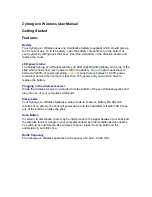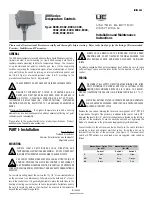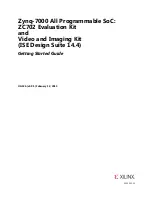
6.
1-37 d-axis Inductance (Ld)
Enter line to common direct axis inductance of
the PM motor.
If only line-line data are available, divide the line-
line value with 2 to achieve the line-common
(starpoint) value.
7.
1-40 Back EMF at 1000 RPM
Enter line to line back EMF of PM Motor at 1000
RPM mechanical speed (RMS value). Back EMF is
the voltage generated by a PM motor when no
drive is connected and the shaft is turned
externally. Back EMF is normally specified for
nominal motor speed or for 1000 RPM measured
between two lines. If the value is not available for
a motor speed of 1000 RPM, calculate the correct
value as follows: If back EMF is eg. 320 V at 1800
RPM, it can be calculated at 1000 RPM as follows:
Back EMF= (Voltage / RPM)*1000 =
(320/1800)*1000 = 178. This is the value that
must be programmed for
1-40 Back EMF at 1000
RPM
Test Motor Operation
1.
Start the motor at low speed (100 to 200 RPM). If
the motor does not turn, check installation,
general programming and motor data.
2.
Check if start function in
1-70 PM Start Mode
fits
the application requirements.
Rotor detection
This function is the recommended choice for applications
where the motor starts from standstill e.g. pumps or
conveyors. On some motors, an acoustic sound is heard
when the impulse is sent out. This does not harm the
motor.
Parking
This function is the recommended choice for applications
where the motor is rotating at slow speed eg. windmilling
in fan applications.
2-06 Parking Current
and
2-07 Parking
Time
can be adjusted. Increase the factory setting of these
parameters for applications with high inertia.
Start the motor at nominal speed. In case the application
does not run well, check the VVC
plus
PM settings.
Recommendations in different applications can be seen in
Application
Settings
Low inertia applications
I
Load
/I
Motor
<5
1-17 Voltage filter time const.
to be
increased by factor 5 to 10
1-14 Damping Gain
should be
reduced
1-66 Min. Current at Low Speed
should be reduced (<100%)
Low inertia applications
50>I
Load
/I
Motor
>5
Keep calculated values
High inertia applications
I
Load
/I
Motor
> 50
1-14 Damping Gain
,
1-15 Low Speed
Filter Time Const.
and
1-16 High
Speed Filter Time Const.
should be
increased
High load at low speed
<30% (rated speed)
1-17 Voltage filter time const.
should
be increased
1-66 Min. Current at Low Speed
should be increased (>100% for
longer time can overheat the motor)
Table 3.2 Recommendations in Different Applications
If the motor starts oscillating at a certain speed, increase
1-14 Damping Gain
. Increase the value in small steps.
Depending on the motor, a good value for this parameter
can be 10% or 100% higher than the default value.
Starting torque can be adjusted in
1-66 Min. Current at Low
Speed
. 100% provides nominal torque as starting torque.
3.6 Automatic Motor Adaptation
Automatic motor adaptation (AMA) is a test procedure that
measures the electrical characteristics of the motor to
optimize compatibility between the frequency converter
and the motor.
•
The frequency converter builds a mathematical
model of the motor for regulating output motor
current. The procedure also tests the input phase
balance of electrical power. It compares the
motor characteristics with the data entered in
parameters
1-20 Motor Power [kW]
to
1-25 Motor
Nominal Speed
.
•
It does not cause the motor to run or harm to
the motor
•
Some motors may be unable to run the complete
version of the test. In that case, select
Enable
reduced AMA
•
If an output filter is connected to the motor,
select
Enable reduced AMA
•
If warnings or alarms occur, see
•
Run this procedure on a cold motor for best
results
Start Up and Functional Tes...
VLT
®
AutomationDrive Operating
Instructions
28
MG33AM02 - VLT
®
is a registered Danfoss trademark
3
3
















































